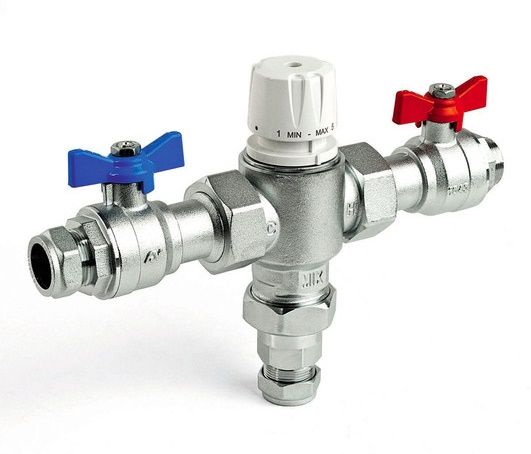Thermostatic Mixing Valve Testing Explained: All You Need to Know

Ever wondered how to balance hot and cold water during your shower? Keep reading how the thermostatic mixing valve makes this possible!

Does your body crave a steamy hot shower each morning? Join the club. Who doesn’t love the feeling of hot water on their bodies? A hot shower comes with numerous benefits, from easing stress to muscle relaxation—especially after that intense full body workout. But have you ever wondered how you always manage to achieve that perfect and constant balance of hot & cold water flow? There’s absolutely nothing random about this harmonious flow. A Thermostatic Mixing Valve (TMV) is responsible for that. It works by blending and regulating cold & hot water temperatures. Now, as you can imagine, without regular testing of the Thermostatic Mixing Valve, malfunctions of the unit can occur. This can have devastating effects. Keep reading to learn more about Thermostatic Mixing Valve Testing and why it’s important.
The Dangers Associated with Drastic Water Temperature Changes
Sudden and drastic water temperatures changes while showering can harm your body. In actual fact, the resultant injuries can actually land you in hospital. How? The absence—or malfunction—of a Thermostatic Mixing Valve in your plumbing system means that your water temperature won’t be regulated. As a result, it can suddenly become too hold or too cold while you’re taking a shower. And neither are desirable circumstances.
Too Hot?
Extremely hot water suddenly spewing out of the shower head can cause burns. Unfortunately the elderly and young children are more susceptible to third degree burns caused by scalding water.

Too Cold?
Cold water unexpectedly pouring down on you while showering can result in thermal shock. The initial shock usually causes the affected individual to immediately jump backwards in an attempt to escape the extreme water temperatures. In worst cases, this causes slips and falls which can result in serious bodily injuries like concussions or even broken bones.
The Solution: Thermostatic Mixing Valve Installation and Testing
The only way to ensure that such adverse effects don’t occur is by installing a Thermostatic Mixing Valve. Fortunately, both residential and commercial properties are installing TMVs to ensure user safety. Gyms, hospitals and beauty salons are amongst the facilities that have TMVs installed in their plumbing systems. But installing a TMV is only the first step. Periodic checks on the valve’s operation are crucial to ensure that it’s functioning properly. And this is what is referred to as Thermostatic Mixing Valve Testing.

How Often Should Thermostatic Mixing Valve Testing Be Conducted?
Different plumbing contractors have different testing periods. But as a rule of thumb, periodic checks on the valves should be conducted at least once every year. In this case, the TMV should be verified against the original set temperature to establish whether it’s the same or not. If it’s a first-time installation, the contractor should conduct a full in-service test on the valve after 6-8 weeks. Depending on the results gathered from this check, additional checks are then conducted. We list a few possible results and the recommended action plan:
- If no significant change in mixed water temperature is noted, the next test can be conducted in 24-28 weeks.
- If slight variations in the water temperatures are detected, the necessary temperature adjustments must be made immediately. After which, the next in-service test should be done in 24-28 weeks.
- If major changes in the water temperature are picked up, again the necessary temperature adjustments should be made immediately. The next in-service testing should then be done in 18-21 weeks.
Only then can the plumbing contractor determine the subsequent testing periods depending on the results from the previous checks. In other words, during which testing period did the TMV record slight changes in water temperatures? That should be the testing interval going forth.
Important: Note that variations in water temperatures detected during the periodic checks could be a result of changes in water supply conditions. For this reason, an audit must be conducted on the water supplies too. Following which a remedial action plan is drafted from information gathered.
Thermostatic Mixed Valve Testing Procedure
Generally, the testing procedure depends on the type of Thermostatic Mixing Valve installed. But regardless of the type of valve, the following basic steps are to be followed:
- Measure the mixed water temperature
- Isolate the cold water supply to the TMV
- Wait for at least five seconds
- Check if the water temperature is below 46ᵒC
- If there’s no significant temperature change (2ᵒC or less) it means the valve is performing optimally
- If the temperature changes exceed 2ᵒC, it means that the valve isn’t working and a full in-service test is necessary
Final Words
It’s clear that TMV testing is an extremely crucial and necessary procedure to safeguard everyone involved. It’s in your best interests, whether you’re a home or business owner, to ensure that regular checks are done on your plumbing systems. We can’t over emphasise the need to hire a reputable and knowledgeable plumbing company to handle this procedure. Not only will such a company possess the necessary knowhow but resources to conduct the test effectively. With that said, when are you scheduling your Thermostatic Mixing Valve Testing appointment?







Leave a Comment